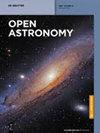明亮高红移类星体的远红外发射
IF 0.5
4区 物理与天体物理
Q4 ASTRONOMY & ASTROPHYSICS
引用次数: 0
摘要
在高红移(z≤6 z \gtrsim 6)处探测到的大多数类星体都能强烈地发射出绝对星等为M 1450 Å、AB ~−(29 - 27)M_1450 {}{\mathring{\rm A}、AB }\hspace{0.33em}\sim - \hspace{0.33em}\left (29 \hspace{0.1em}\text{–}\hspace{0.1em} 27)的紫外辐射。其中一些类星体在[CII] 158 μ m - 158线和远红外(FIR)连续光谱中具有较高的光度,这使得这些类星体中有大量的冷尘埃气体。我们研究了一个被低覆盖因子的稠密云团遮挡的微吸收超大质量黑洞(SMBH)的[CII] 158 μ m 158的光度与FIR连续体之间的关系。我们发现,低覆盖因子的致密云可以在[CII] 158 μ m - 158线和下面的FIR连续体中提供足够的亮度,以重现在高红移类星体中观测到的[CII]-FIR比,而SMBH质量为m•~ 10 9 m⊙M_ \hspace{0.33em}{\rm{\mu }}{\rm{m}}\hspace{0.33em}{\rm{\mu }}{\rm{m}}\hspace{0.33em}{\rm{\mu }}{\rm{m}}{}{\bullet}\hspace{0.33em}\sim 10^9M_ \hspace{0.33em}{}{}{}{\odot。我们注意到,许多遥远的活动星系核都是为了避免近红外(IR)波长的探测;如果是这样的话,就需要进行盲目IR/FIR调查。}本文章由计算机程序翻译,如有差异,请以英文原文为准。
Far-IR emission from bright high-redshift quasars
Abstract The majority of quasars detected at high redshifts ( z ≳ 6 z\gtrsim 6 ) strongly emit ultraviolet radiation with absolute magnitudes at rest-frame M 1450 Å , A B ∼ − ( 29 – 27 ) {M}_{1450\mathring{\rm A} ,AB}\hspace{0.33em} \sim \hspace{0.33em}-\left(29\hspace{0.1em}\text{–}\hspace{0.1em}27) . Some of them have high luminosities in [CII] 158 μ m 158\hspace{0.33em}{\rm{\mu }}{\rm{m}} line and in far-infrared (FIR) continuum, which leads to the expectation of a large amount of much cold dusty gas in these quasars. We have studied the relation between luminosities in the [CII] 158 μ m 158\hspace{0.33em}{\rm{\mu }}{\rm{m}} and the FIR continuum for a slightly absorbed supermassive black hole (SMBH) obscured by an ensemble of dense clouds with a low covering factor. We have found that dense clouds with a low covering factor can give sufficient luminosities in [CII] 158 μ m 158\hspace{0.33em}{\rm{\mu }}{\rm{m}} line and the underlying FIR continuum to reproduce the [CII]-FIR ratio observed in high-redshift quasars for a reasonable SMBH mass of M • ∼ 1 0 9 M ⊙ {M}_{\bullet }\hspace{0.33em} \sim \hspace{0.33em}1{0}^{9}{M}_{\odot } . We note that many distant mildly/heavily obscured active galactic nuclei are to avoid detection in near-infrared (IR) wavelengths; if this is the case, blind IR/FIR surveys are needed.
求助全文
通过发布文献求助,成功后即可免费获取论文全文。
去求助
来源期刊

Open Astronomy
Physics and Astronomy-Astronomy and Astrophysics
CiteScore
1.30
自引率
14.30%
发文量
37
审稿时长
16 weeks
期刊介绍:
The journal disseminates research in both observational and theoretical astronomy, astrophysics, solar physics, cosmology, galactic and extragalactic astronomy, high energy particles physics, planetary science, space science and astronomy-related astrobiology, presenting as well the surveys dedicated to astronomical history and education.
 求助内容:
求助内容: 应助结果提醒方式:
应助结果提醒方式:


